Integrated Reporting at Eni: A Case Study of Business Transformation
VerifiedAdded on 2023/06/15
|27
|4441
|349
Case Study
AI Summary
This case study examines Eni's transition from traditional financial reporting to integrated reporting (IR), driven by the need for enhanced stakeholder communication, sustainability, and compliance with evolving regulatory standards. The project details Eni's objectives, strategies, and the involvement of various departments in implementing a two-year plan aligned with global sustainability goals. Key stakeholders, including providers of capital finance, employees, customers, policymakers, local communities, suppliers, and partners, are identified, and their roles in Eni's operations are discussed. The analysis covers Eni's business context, including its vision, strategy in exploration and production, gas and power, refining & marketing and chemicals, strategic goals, key success factors, and KPIs. It also addresses the challenges Eni faces, such as the shift towards environment-friendly energy sources and the integration of IR into its sustainability structure, concluding with key findings and recommendations for improved business processes. Desklib offers this and many more solved assignments for students.
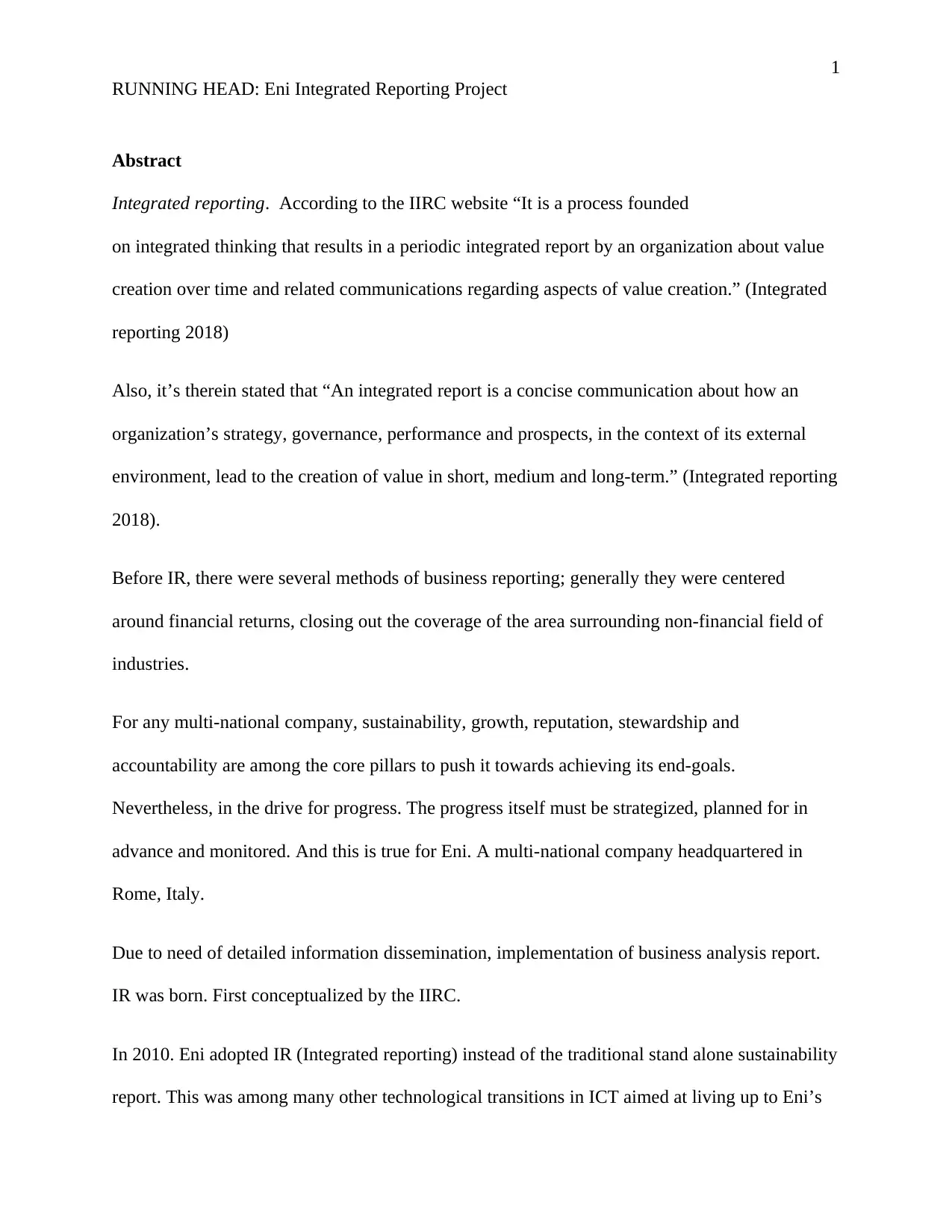
1
RUNNING HEAD: Eni Integrated Reporting Project
Abstract
Integrated reporting. According to the IIRC website “It is a process founded
on integrated thinking that results in a periodic integrated report by an organization about value
creation over time and related communications regarding aspects of value creation.” (Integrated
reporting 2018)
Also, it’s therein stated that “An integrated report is a concise communication about how an
organization’s strategy, governance, performance and prospects, in the context of its external
environment, lead to the creation of value in short, medium and long-term.” (Integrated reporting
2018).
Before IR, there were several methods of business reporting; generally they were centered
around financial returns, closing out the coverage of the area surrounding non-financial field of
industries.
For any multi-national company, sustainability, growth, reputation, stewardship and
accountability are among the core pillars to push it towards achieving its end-goals.
Nevertheless, in the drive for progress. The progress itself must be strategized, planned for in
advance and monitored. And this is true for Eni. A multi-national company headquartered in
Rome, Italy.
Due to need of detailed information dissemination, implementation of business analysis report.
IR was born. First conceptualized by the IIRC.
In 2010. Eni adopted IR (Integrated reporting) instead of the traditional stand alone sustainability
report. This was among many other technological transitions in ICT aimed at living up to Eni’s
RUNNING HEAD: Eni Integrated Reporting Project
Abstract
Integrated reporting. According to the IIRC website “It is a process founded
on integrated thinking that results in a periodic integrated report by an organization about value
creation over time and related communications regarding aspects of value creation.” (Integrated
reporting 2018)
Also, it’s therein stated that “An integrated report is a concise communication about how an
organization’s strategy, governance, performance and prospects, in the context of its external
environment, lead to the creation of value in short, medium and long-term.” (Integrated reporting
2018).
Before IR, there were several methods of business reporting; generally they were centered
around financial returns, closing out the coverage of the area surrounding non-financial field of
industries.
For any multi-national company, sustainability, growth, reputation, stewardship and
accountability are among the core pillars to push it towards achieving its end-goals.
Nevertheless, in the drive for progress. The progress itself must be strategized, planned for in
advance and monitored. And this is true for Eni. A multi-national company headquartered in
Rome, Italy.
Due to need of detailed information dissemination, implementation of business analysis report.
IR was born. First conceptualized by the IIRC.
In 2010. Eni adopted IR (Integrated reporting) instead of the traditional stand alone sustainability
report. This was among many other technological transitions in ICT aimed at living up to Eni’s
Paraphrase This Document
Need a fresh take? Get an instant paraphrase of this document with our AI Paraphraser
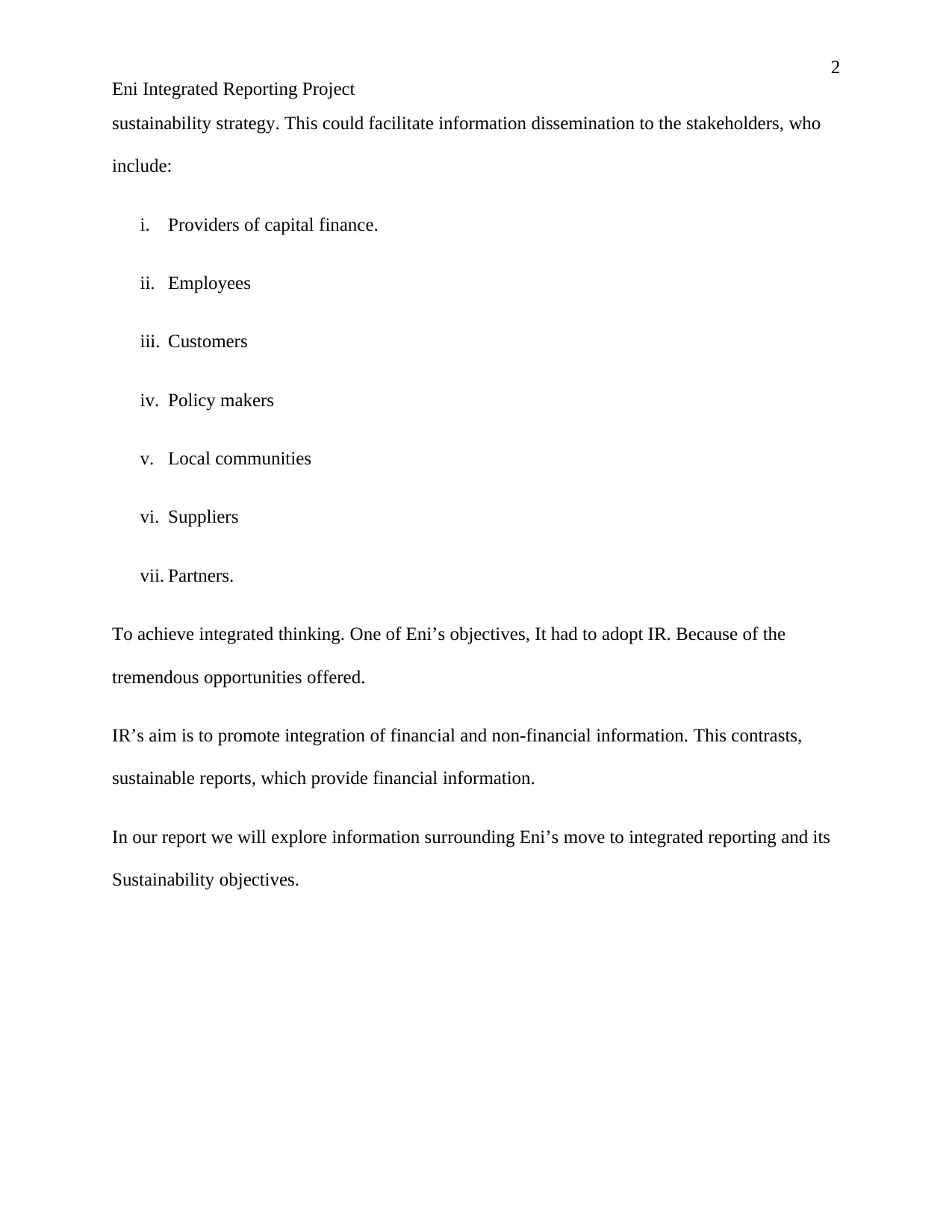
2
Eni Integrated Reporting Project
sustainability strategy. This could facilitate information dissemination to the stakeholders, who
include:
i. Providers of capital finance.
ii. Employees
iii. Customers
iv. Policy makers
v. Local communities
vi. Suppliers
vii. Partners.
To achieve integrated thinking. One of Eni’s objectives, It had to adopt IR. Because of the
tremendous opportunities offered.
IR’s aim is to promote integration of financial and non-financial information. This contrasts,
sustainable reports, which provide financial information.
In our report we will explore information surrounding Eni’s move to integrated reporting and its
Sustainability objectives.
Eni Integrated Reporting Project
sustainability strategy. This could facilitate information dissemination to the stakeholders, who
include:
i. Providers of capital finance.
ii. Employees
iii. Customers
iv. Policy makers
v. Local communities
vi. Suppliers
vii. Partners.
To achieve integrated thinking. One of Eni’s objectives, It had to adopt IR. Because of the
tremendous opportunities offered.
IR’s aim is to promote integration of financial and non-financial information. This contrasts,
sustainable reports, which provide financial information.
In our report we will explore information surrounding Eni’s move to integrated reporting and its
Sustainability objectives.
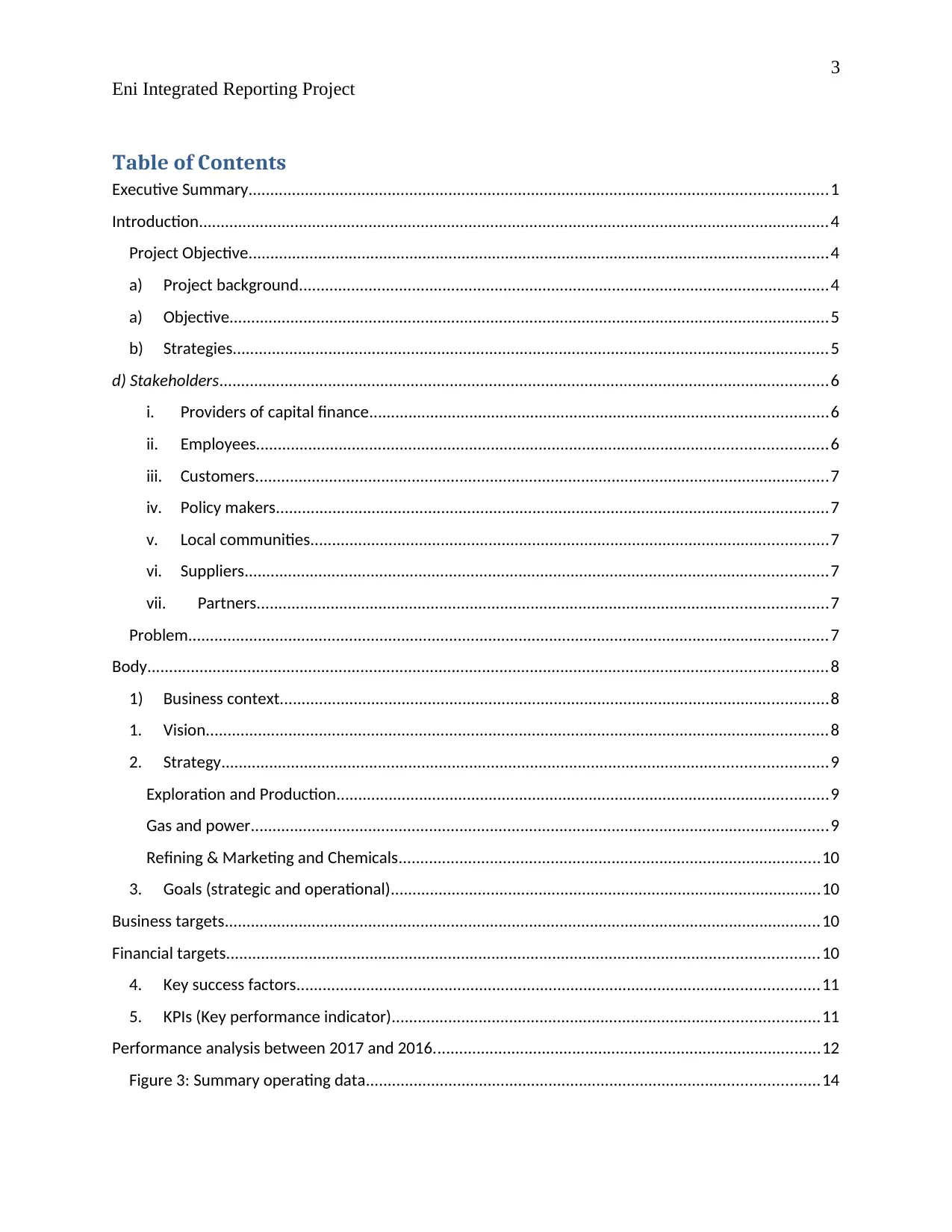
3
Eni Integrated Reporting Project
Table of Contents
Executive Summary.....................................................................................................................................1
Introduction.................................................................................................................................................4
Project Objective.....................................................................................................................................4
a) Project background..........................................................................................................................4
a) Objective..........................................................................................................................................5
b) Strategies.........................................................................................................................................5
d) Stakeholders............................................................................................................................................6
i. Providers of capital finance.........................................................................................................6
ii. Employees...................................................................................................................................6
iii. Customers....................................................................................................................................7
iv. Policy makers...............................................................................................................................7
v. Local communities.......................................................................................................................7
vi. Suppliers......................................................................................................................................7
vii. Partners...................................................................................................................................7
Problem...................................................................................................................................................7
Body............................................................................................................................................................8
1) Business context..............................................................................................................................8
1. Vision...............................................................................................................................................8
2. Strategy...........................................................................................................................................9
Exploration and Production.................................................................................................................9
Gas and power.....................................................................................................................................9
Refining & Marketing and Chemicals.................................................................................................10
3. Goals (strategic and operational)...................................................................................................10
Business targets.........................................................................................................................................10
Financial targets........................................................................................................................................10
4. Key success factors........................................................................................................................11
5. KPIs (Key performance indicator)..................................................................................................11
Performance analysis between 2017 and 2016.........................................................................................12
Figure 3: Summary operating data........................................................................................................14
Eni Integrated Reporting Project
Table of Contents
Executive Summary.....................................................................................................................................1
Introduction.................................................................................................................................................4
Project Objective.....................................................................................................................................4
a) Project background..........................................................................................................................4
a) Objective..........................................................................................................................................5
b) Strategies.........................................................................................................................................5
d) Stakeholders............................................................................................................................................6
i. Providers of capital finance.........................................................................................................6
ii. Employees...................................................................................................................................6
iii. Customers....................................................................................................................................7
iv. Policy makers...............................................................................................................................7
v. Local communities.......................................................................................................................7
vi. Suppliers......................................................................................................................................7
vii. Partners...................................................................................................................................7
Problem...................................................................................................................................................7
Body............................................................................................................................................................8
1) Business context..............................................................................................................................8
1. Vision...............................................................................................................................................8
2. Strategy...........................................................................................................................................9
Exploration and Production.................................................................................................................9
Gas and power.....................................................................................................................................9
Refining & Marketing and Chemicals.................................................................................................10
3. Goals (strategic and operational)...................................................................................................10
Business targets.........................................................................................................................................10
Financial targets........................................................................................................................................10
4. Key success factors........................................................................................................................11
5. KPIs (Key performance indicator)..................................................................................................11
Performance analysis between 2017 and 2016.........................................................................................12
Figure 3: Summary operating data........................................................................................................14
⊘ This is a preview!⊘
Do you want full access?
Subscribe today to unlock all pages.

Trusted by 1+ million students worldwide
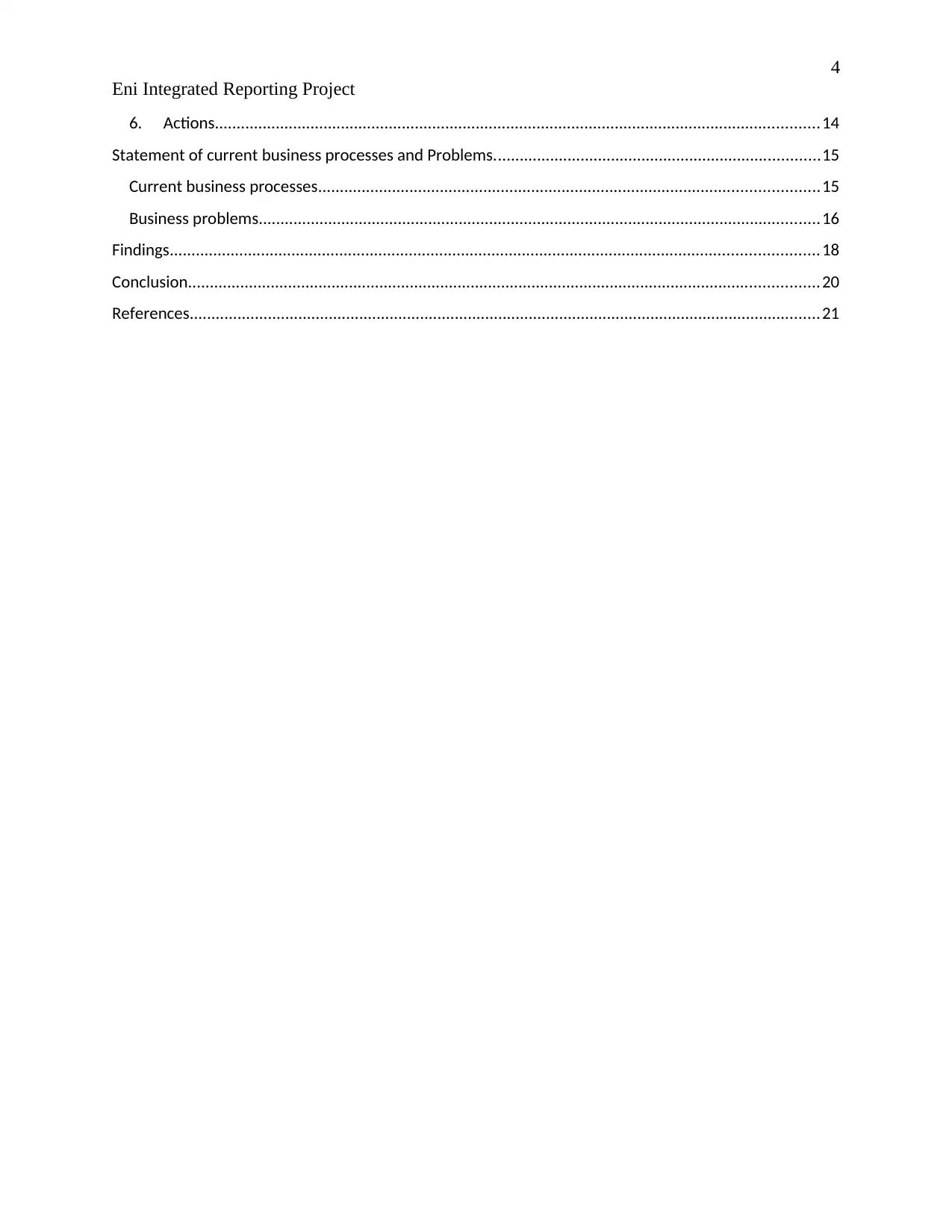
4
Eni Integrated Reporting Project
6. Actions...........................................................................................................................................14
Statement of current business processes and Problems...........................................................................15
Current business processes...................................................................................................................15
Business problems.................................................................................................................................16
Findings.....................................................................................................................................................18
Conclusion.................................................................................................................................................20
References.................................................................................................................................................21
Eni Integrated Reporting Project
6. Actions...........................................................................................................................................14
Statement of current business processes and Problems...........................................................................15
Current business processes...................................................................................................................15
Business problems.................................................................................................................................16
Findings.....................................................................................................................................................18
Conclusion.................................................................................................................................................20
References.................................................................................................................................................21
Paraphrase This Document
Need a fresh take? Get an instant paraphrase of this document with our AI Paraphraser
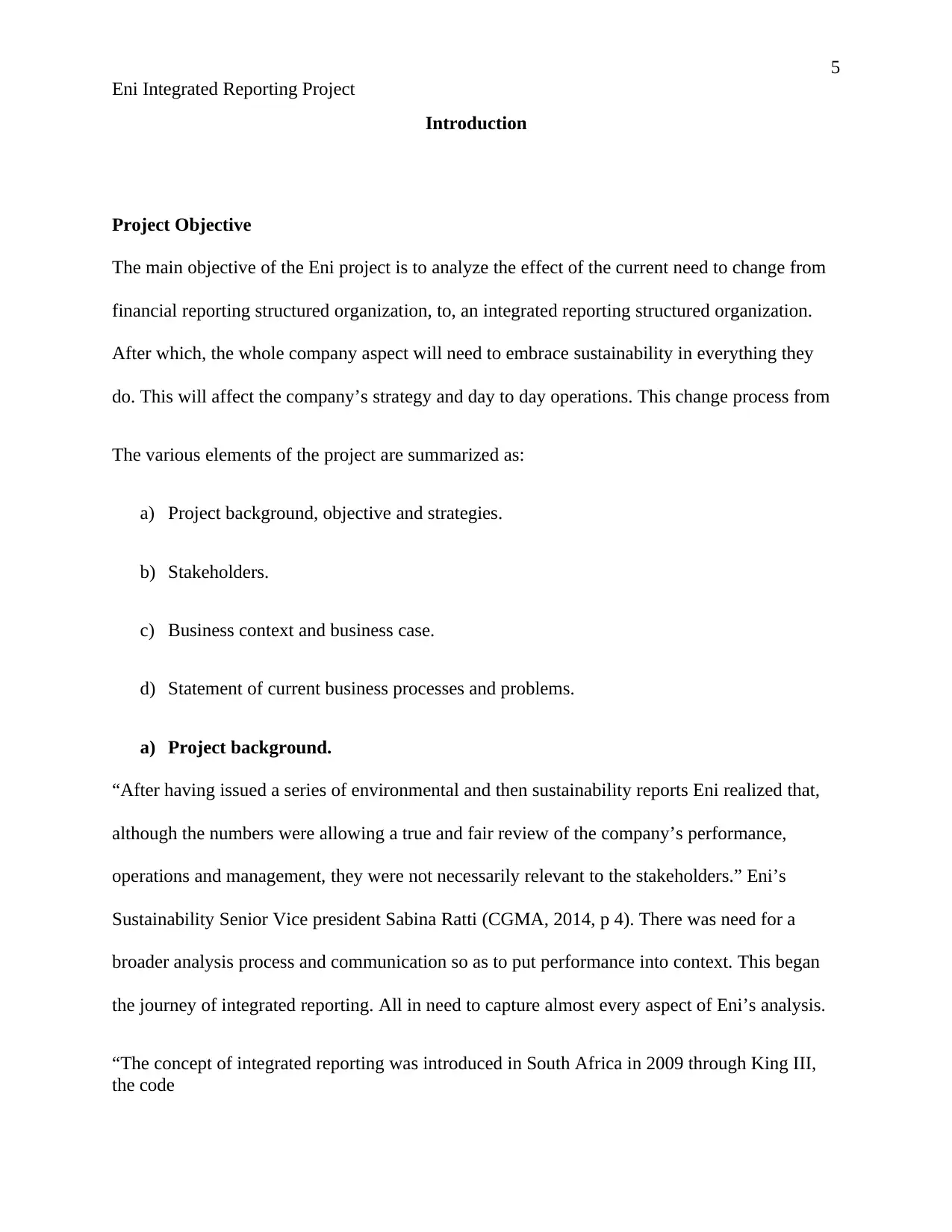
5
Eni Integrated Reporting Project
Introduction
Project Objective
The main objective of the Eni project is to analyze the effect of the current need to change from
financial reporting structured organization, to, an integrated reporting structured organization.
After which, the whole company aspect will need to embrace sustainability in everything they
do. This will affect the company’s strategy and day to day operations. This change process from
The various elements of the project are summarized as:
a) Project background, objective and strategies.
b) Stakeholders.
c) Business context and business case.
d) Statement of current business processes and problems.
a) Project background.
“After having issued a series of environmental and then sustainability reports Eni realized that,
although the numbers were allowing a true and fair review of the company’s performance,
operations and management, they were not necessarily relevant to the stakeholders.” Eni’s
Sustainability Senior Vice president Sabina Ratti (CGMA, 2014, p 4). There was need for a
broader analysis process and communication so as to put performance into context. This began
the journey of integrated reporting. All in need to capture almost every aspect of Eni’s analysis.
“The concept of integrated reporting was introduced in South Africa in 2009 through King III,
the code
Eni Integrated Reporting Project
Introduction
Project Objective
The main objective of the Eni project is to analyze the effect of the current need to change from
financial reporting structured organization, to, an integrated reporting structured organization.
After which, the whole company aspect will need to embrace sustainability in everything they
do. This will affect the company’s strategy and day to day operations. This change process from
The various elements of the project are summarized as:
a) Project background, objective and strategies.
b) Stakeholders.
c) Business context and business case.
d) Statement of current business processes and problems.
a) Project background.
“After having issued a series of environmental and then sustainability reports Eni realized that,
although the numbers were allowing a true and fair review of the company’s performance,
operations and management, they were not necessarily relevant to the stakeholders.” Eni’s
Sustainability Senior Vice president Sabina Ratti (CGMA, 2014, p 4). There was need for a
broader analysis process and communication so as to put performance into context. This began
the journey of integrated reporting. All in need to capture almost every aspect of Eni’s analysis.
“The concept of integrated reporting was introduced in South Africa in 2009 through King III,
the code

6
Eni Integrated Reporting Project
of corporate governance. The Johannesburg Stock Exchange adopted King III, and all listed
companies
are now required to “apply or explain” the King III principles, of which integrated reporting is
one.
Regulatory requirements around the world and some listing requirements in different parts of the
world are heading in the same direction. Requirements are emerging to increasingly disclose
non-financial performance, such as”. (EYGM, 2014. p 3).
After which in 2010, IIRC sought out to develop a worldwide framework of reporting, it was in
this year that integrated reporting was to be set as a standard of corporate reporting. (EYGM,
2014. P 3).
Behind any successful company or industry, is an integrated thinking approach towards its
operations. From managerial, day-to-day operations, marketing, supervisory and logistics layout
of a company, there is need for a synergy that helps with the streamlining of the forward aims of
the company’s goals. Eni before 2009, had a financial return report approach. This benefitted the
stakeholders, in precise. The financial providers. Locking out every other stakeholder. The
regulators, community and its own strategy. This for a long time has been the case all around the
world. Integrated report presented its tremendous opportunities to put together not only the
financial report but also almost the whole picture. Ranging from:
i. Strategy layout
ii. Financial returns
iii. Statement of the integrated thinking process
iv. Statement of goals
v. Analysis
vi. Effects and recommendations.
Eni Integrated Reporting Project
of corporate governance. The Johannesburg Stock Exchange adopted King III, and all listed
companies
are now required to “apply or explain” the King III principles, of which integrated reporting is
one.
Regulatory requirements around the world and some listing requirements in different parts of the
world are heading in the same direction. Requirements are emerging to increasingly disclose
non-financial performance, such as”. (EYGM, 2014. p 3).
After which in 2010, IIRC sought out to develop a worldwide framework of reporting, it was in
this year that integrated reporting was to be set as a standard of corporate reporting. (EYGM,
2014. P 3).
Behind any successful company or industry, is an integrated thinking approach towards its
operations. From managerial, day-to-day operations, marketing, supervisory and logistics layout
of a company, there is need for a synergy that helps with the streamlining of the forward aims of
the company’s goals. Eni before 2009, had a financial return report approach. This benefitted the
stakeholders, in precise. The financial providers. Locking out every other stakeholder. The
regulators, community and its own strategy. This for a long time has been the case all around the
world. Integrated report presented its tremendous opportunities to put together not only the
financial report but also almost the whole picture. Ranging from:
i. Strategy layout
ii. Financial returns
iii. Statement of the integrated thinking process
iv. Statement of goals
v. Analysis
vi. Effects and recommendations.
⊘ This is a preview!⊘
Do you want full access?
Subscribe today to unlock all pages.

Trusted by 1+ million students worldwide
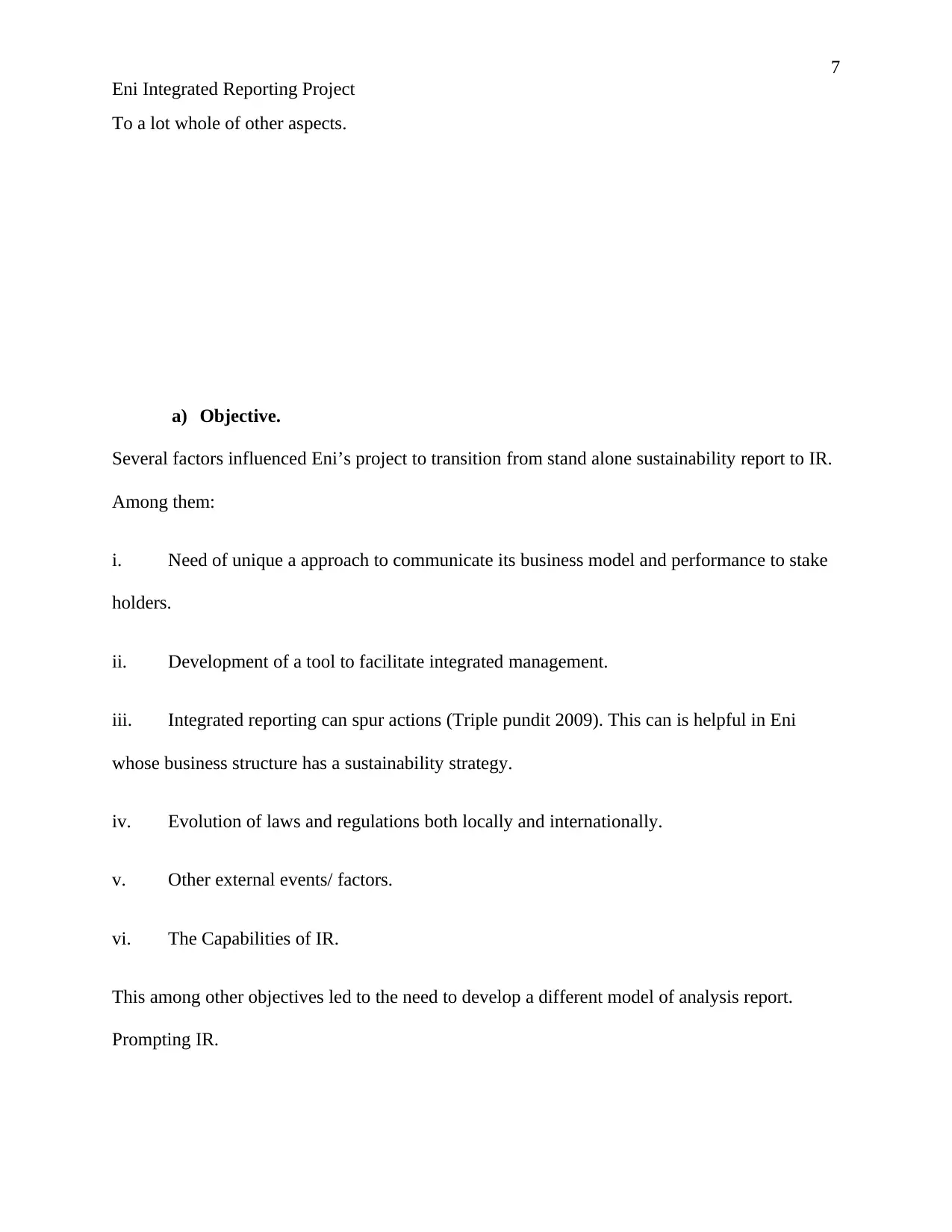
7
Eni Integrated Reporting Project
To a lot whole of other aspects.
a) Objective.
Several factors influenced Eni’s project to transition from stand alone sustainability report to IR.
Among them:
i. Need of unique a approach to communicate its business model and performance to stake
holders.
ii. Development of a tool to facilitate integrated management.
iii. Integrated reporting can spur actions (Triple pundit 2009). This can is helpful in Eni
whose business structure has a sustainability strategy.
iv. Evolution of laws and regulations both locally and internationally.
v. Other external events/ factors.
vi. The Capabilities of IR.
This among other objectives led to the need to develop a different model of analysis report.
Prompting IR.
Eni Integrated Reporting Project
To a lot whole of other aspects.
a) Objective.
Several factors influenced Eni’s project to transition from stand alone sustainability report to IR.
Among them:
i. Need of unique a approach to communicate its business model and performance to stake
holders.
ii. Development of a tool to facilitate integrated management.
iii. Integrated reporting can spur actions (Triple pundit 2009). This can is helpful in Eni
whose business structure has a sustainability strategy.
iv. Evolution of laws and regulations both locally and internationally.
v. Other external events/ factors.
vi. The Capabilities of IR.
This among other objectives led to the need to develop a different model of analysis report.
Prompting IR.
Paraphrase This Document
Need a fresh take? Get an instant paraphrase of this document with our AI Paraphraser
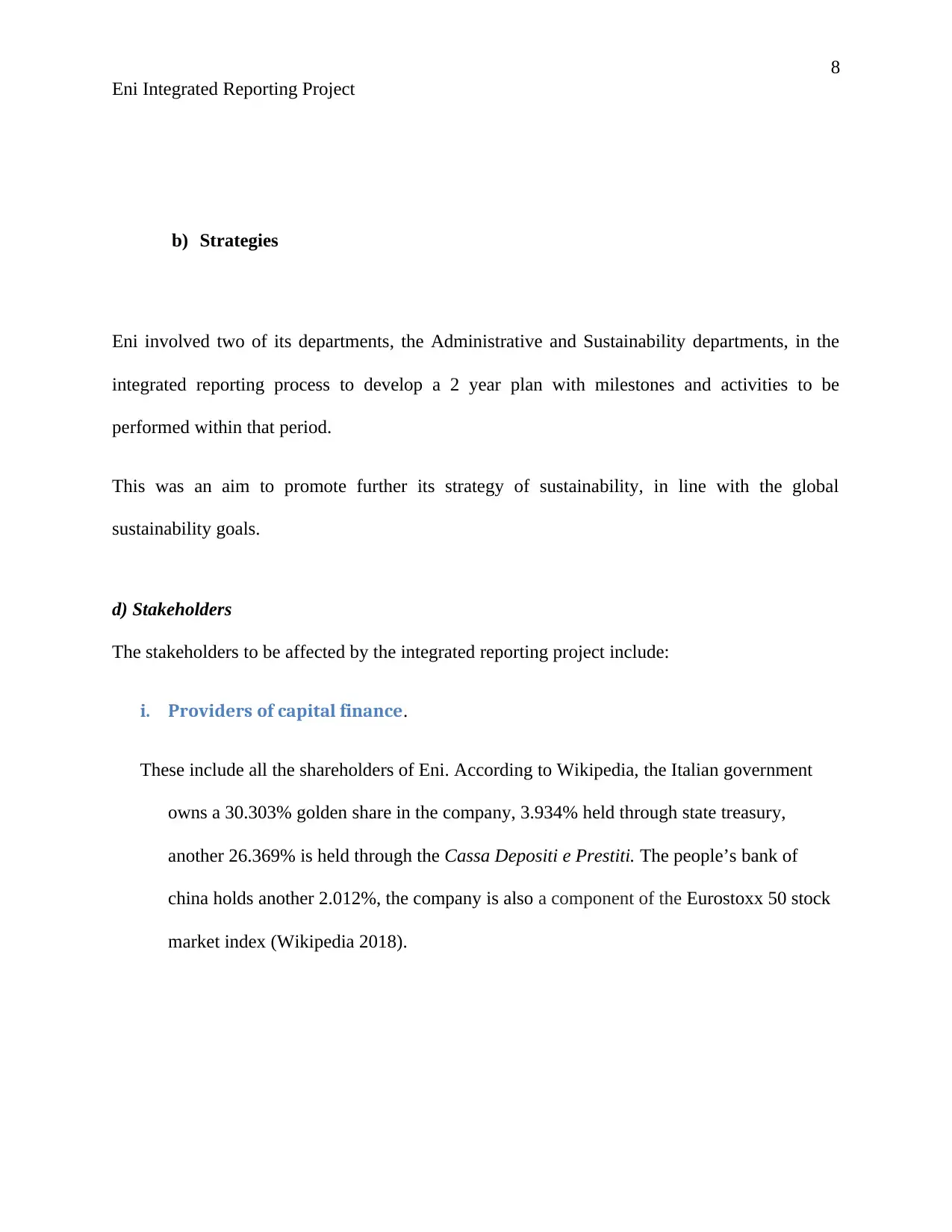
8
Eni Integrated Reporting Project
b) Strategies
Eni involved two of its departments, the Administrative and Sustainability departments, in the
integrated reporting process to develop a 2 year plan with milestones and activities to be
performed within that period.
This was an aim to promote further its strategy of sustainability, in line with the global
sustainability goals.
d) Stakeholders
The stakeholders to be affected by the integrated reporting project include:
i. Providers of capital finance.
These include all the shareholders of Eni. According to Wikipedia, the Italian government
owns a 30.303% golden share in the company, 3.934% held through state treasury,
another 26.369% is held through the Cassa Depositi e Prestiti. The people’s bank of
china holds another 2.012%, the company is also a component of the Eurostoxx 50 stock
market index (Wikipedia 2018).
Eni Integrated Reporting Project
b) Strategies
Eni involved two of its departments, the Administrative and Sustainability departments, in the
integrated reporting process to develop a 2 year plan with milestones and activities to be
performed within that period.
This was an aim to promote further its strategy of sustainability, in line with the global
sustainability goals.
d) Stakeholders
The stakeholders to be affected by the integrated reporting project include:
i. Providers of capital finance.
These include all the shareholders of Eni. According to Wikipedia, the Italian government
owns a 30.303% golden share in the company, 3.934% held through state treasury,
another 26.369% is held through the Cassa Depositi e Prestiti. The people’s bank of
china holds another 2.012%, the company is also a component of the Eurostoxx 50 stock
market index (Wikipedia 2018).

9
Eni Integrated Reporting Project
ii. Employees
Eni boasts of a large number of employees in all the countries it has operations in. This is due
to its principle of being “localized”.
According to Forbes Eni has approximately 33, 866 employees as of may 2017 (Forbes
2017).
iii. Customers
iv. Policy makers
Eni being a multi-national company, it is widely affected by the laws and regulations of business
operations set out by the governments in those countries, this considered, there must be a
structure that has to envision the merging of the interests both of the local country and that of the
Eni.
v. Local communities
Local communities around which Eni carries out its upstream and also downstream activities
play a huge and important role in the success of Eni’s bigger picture. They:
Provide human resources, i.e. manpower
Market
Guide to the raw materials. Etcetera
Eni Integrated Reporting Project
ii. Employees
Eni boasts of a large number of employees in all the countries it has operations in. This is due
to its principle of being “localized”.
According to Forbes Eni has approximately 33, 866 employees as of may 2017 (Forbes
2017).
iii. Customers
iv. Policy makers
Eni being a multi-national company, it is widely affected by the laws and regulations of business
operations set out by the governments in those countries, this considered, there must be a
structure that has to envision the merging of the interests both of the local country and that of the
Eni.
v. Local communities
Local communities around which Eni carries out its upstream and also downstream activities
play a huge and important role in the success of Eni’s bigger picture. They:
Provide human resources, i.e. manpower
Market
Guide to the raw materials. Etcetera
⊘ This is a preview!⊘
Do you want full access?
Subscribe today to unlock all pages.

Trusted by 1+ million students worldwide

10
Eni Integrated Reporting Project
vi. Suppliers
vii. Partners.
Problem
”The major problem facing Eni in the near future, is the growing trend towards environment
friendly energy sources and non-toxic chemicals…” (William & Todd, 2016).
The other issue is integration of IR into the sustainability structure of the company.
Eni Integrated Reporting Project
vi. Suppliers
vii. Partners.
Problem
”The major problem facing Eni in the near future, is the growing trend towards environment
friendly energy sources and non-toxic chemicals…” (William & Todd, 2016).
The other issue is integration of IR into the sustainability structure of the company.
Paraphrase This Document
Need a fresh take? Get an instant paraphrase of this document with our AI Paraphraser
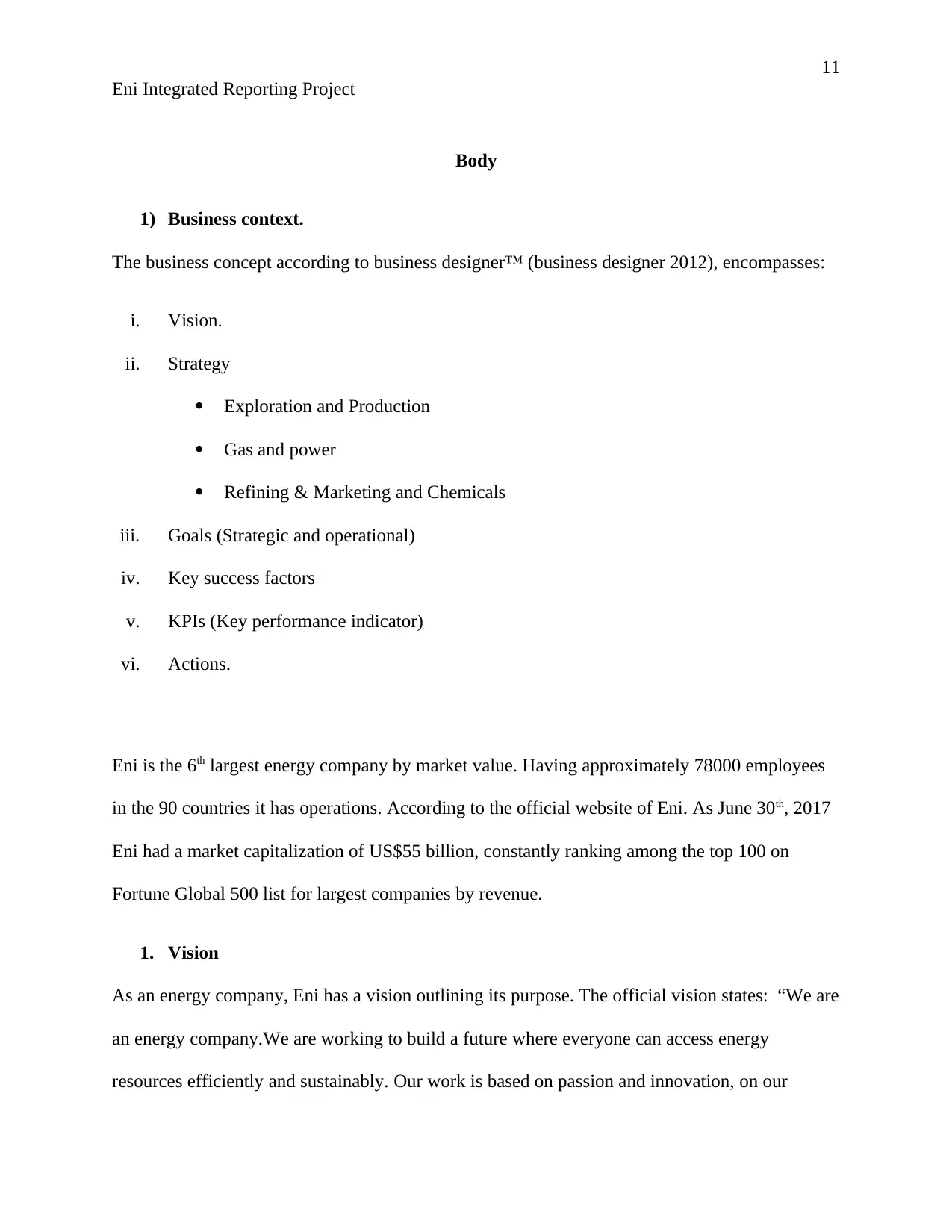
11
Eni Integrated Reporting Project
Body
1) Business context.
The business concept according to business designer™ (business designer 2012), encompasses:
i. Vision.
ii. Strategy
Exploration and Production
Gas and power
Refining & Marketing and Chemicals
iii. Goals (Strategic and operational)
iv. Key success factors
v. KPIs (Key performance indicator)
vi. Actions.
Eni is the 6th largest energy company by market value. Having approximately 78000 employees
in the 90 countries it has operations. According to the official website of Eni. As June 30th, 2017
Eni had a market capitalization of US$55 billion, constantly ranking among the top 100 on
Fortune Global 500 list for largest companies by revenue.
1. Vision
As an energy company, Eni has a vision outlining its purpose. The official vision states: “We are
an energy company.We are working to build a future where everyone can access energy
resources efficiently and sustainably. Our work is based on passion and innovation, on our
Eni Integrated Reporting Project
Body
1) Business context.
The business concept according to business designer™ (business designer 2012), encompasses:
i. Vision.
ii. Strategy
Exploration and Production
Gas and power
Refining & Marketing and Chemicals
iii. Goals (Strategic and operational)
iv. Key success factors
v. KPIs (Key performance indicator)
vi. Actions.
Eni is the 6th largest energy company by market value. Having approximately 78000 employees
in the 90 countries it has operations. According to the official website of Eni. As June 30th, 2017
Eni had a market capitalization of US$55 billion, constantly ranking among the top 100 on
Fortune Global 500 list for largest companies by revenue.
1. Vision
As an energy company, Eni has a vision outlining its purpose. The official vision states: “We are
an energy company.We are working to build a future where everyone can access energy
resources efficiently and sustainably. Our work is based on passion and innovation, on our
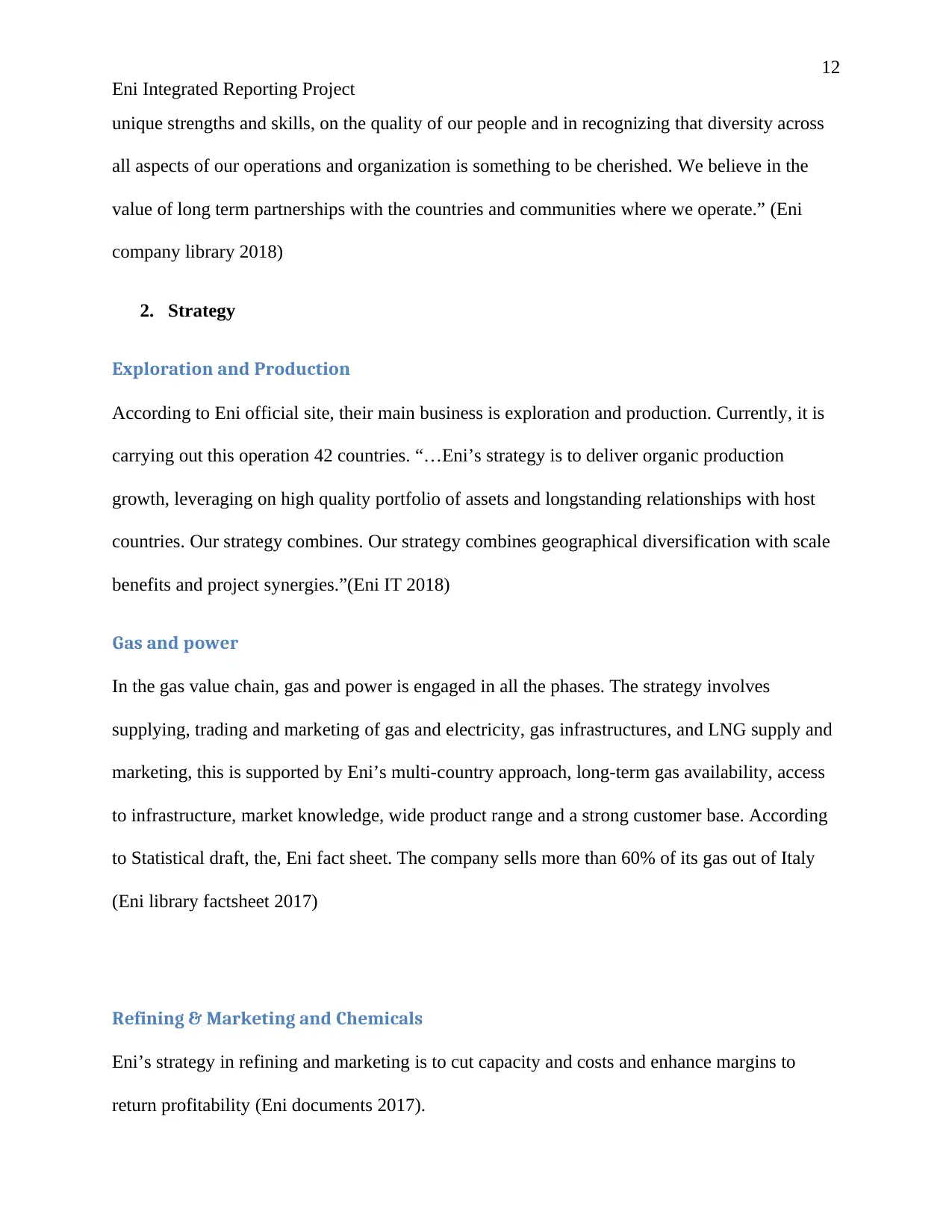
12
Eni Integrated Reporting Project
unique strengths and skills, on the quality of our people and in recognizing that diversity across
all aspects of our operations and organization is something to be cherished. We believe in the
value of long term partnerships with the countries and communities where we operate.” (Eni
company library 2018)
2. Strategy
Exploration and Production
According to Eni official site, their main business is exploration and production. Currently, it is
carrying out this operation 42 countries. “…Eni’s strategy is to deliver organic production
growth, leveraging on high quality portfolio of assets and longstanding relationships with host
countries. Our strategy combines. Our strategy combines geographical diversification with scale
benefits and project synergies.”(Eni IT 2018)
Gas and power
In the gas value chain, gas and power is engaged in all the phases. The strategy involves
supplying, trading and marketing of gas and electricity, gas infrastructures, and LNG supply and
marketing, this is supported by Eni’s multi-country approach, long-term gas availability, access
to infrastructure, market knowledge, wide product range and a strong customer base. According
to Statistical draft, the, Eni fact sheet. The company sells more than 60% of its gas out of Italy
(Eni library factsheet 2017)
Refining & Marketing and Chemicals
Eni’s strategy in refining and marketing is to cut capacity and costs and enhance margins to
return profitability (Eni documents 2017).
Eni Integrated Reporting Project
unique strengths and skills, on the quality of our people and in recognizing that diversity across
all aspects of our operations and organization is something to be cherished. We believe in the
value of long term partnerships with the countries and communities where we operate.” (Eni
company library 2018)
2. Strategy
Exploration and Production
According to Eni official site, their main business is exploration and production. Currently, it is
carrying out this operation 42 countries. “…Eni’s strategy is to deliver organic production
growth, leveraging on high quality portfolio of assets and longstanding relationships with host
countries. Our strategy combines. Our strategy combines geographical diversification with scale
benefits and project synergies.”(Eni IT 2018)
Gas and power
In the gas value chain, gas and power is engaged in all the phases. The strategy involves
supplying, trading and marketing of gas and electricity, gas infrastructures, and LNG supply and
marketing, this is supported by Eni’s multi-country approach, long-term gas availability, access
to infrastructure, market knowledge, wide product range and a strong customer base. According
to Statistical draft, the, Eni fact sheet. The company sells more than 60% of its gas out of Italy
(Eni library factsheet 2017)
Refining & Marketing and Chemicals
Eni’s strategy in refining and marketing is to cut capacity and costs and enhance margins to
return profitability (Eni documents 2017).
⊘ This is a preview!⊘
Do you want full access?
Subscribe today to unlock all pages.

Trusted by 1+ million students worldwide
1 out of 27
Related Documents
Your All-in-One AI-Powered Toolkit for Academic Success.
+13062052269
info@desklib.com
Available 24*7 on WhatsApp / Email
![[object Object]](/_next/static/media/star-bottom.7253800d.svg)
Unlock your academic potential
Copyright © 2020–2025 A2Z Services. All Rights Reserved. Developed and managed by ZUCOL.




